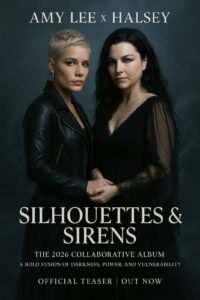In interviews leading up to the album, both artists spoke about an immediate creative chemistry. Halsey admitted to idolizing Amy Lee during her teenage years, often crediting Evanescence for showing her that beauty and darkness could coexist. Amy, in turn, said she admired Halsey’s fearless approach to pop—a genre often criticized for being surface-level, which Halsey redefined through her honesty and edge. Their sessions weren’t just about making music; they were about building a language between two souls who’d been unknowingly in conversation for years.
Much of their new material, including tracks teased under the album title Silhouettes & Sirens, is rooted in duality. The “silhouettes” speak to their shadow selves—the parts they’ve both learned to embrace rather than suppress. The “sirens” reference their voices, not only literal but metaphorical: the allure, the danger, the warning, the seduction. The result is an album that doesn’t settle for one sound. Instead, it blends gothic piano arrangements, industrial beats, orchestral swells, and whispered vocals into something deeply immersive.

They’ve written songs about losing and reclaiming control, about the ghosts of fame, about how femininity can be both weapon and wound. There’s even a track rumored to have been written after a long, late-night conversation about their complicated relationships with their younger selves. It’s not a record chasing trends—it’s one that stands defiant in the face of them.
But what’s most striking is how they uplift each other’s strengths. Amy’s vocals reach chilling heights on choruses where Halsey’s more conversational tone adds intimacy. Halsey’s poetic lyrics give Amy’s dramatic soundscapes new textures. Neither overshadows the other. Instead, they orbit—sometimes in tension, sometimes in harmony—but always in balance. It’s the sound of two artists trusting each other deeply.
Their visual direction follows the same theme. Early promotional photos depict the duo in gothic cathedral ruins and mist-filled forests, wearing matching black silhouettes, sometimes facing away from each other, sometimes blending into one. It’s not aesthetic for aesthetic’s sake—it reflects the deeper concept of identity dissolving and re-forming in collaboration.
Fans, of course, are ecstatic. From Evanescence diehards in their 30s to Gen Z Halsey devotees, the response has been overwhelmingly emotional. Social media threads are filled with gratitude, personal stories, and even tears. It’s rare to see two artists from different eras bridge such a meaningful gap without either compromising their identity. Amy and Halsey didn’t just meet in the middle—they created a new space entirely.
This collaboration also challenges how we think about generational artistry. In a culture obsessed with youth and novelty, Amy Lee’s presence reminds listeners that artistic power doesn’t diminish with time—it evolves. And Halsey, already a veteran in her own right, shows that reverence for the past can inspire the future. Their union sends a quiet message to the industry: growth doesn’t have to mean reinvention at the expense of roots.